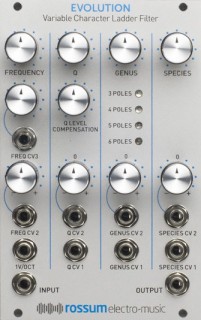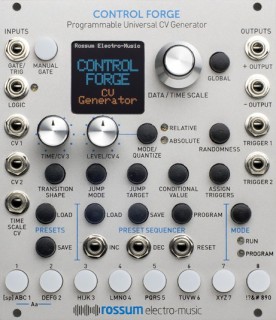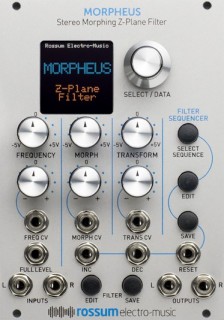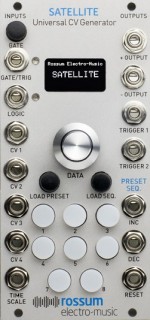At the 2016 NAMM Show, we talked with synthesizer pioneer Dave Rossum, who co-founded E-Mu Systems in 1971 and created the E-Mu Modular System.
Rossum has a new company, Rossum Electro-Music. In the video above, Rossum tells the story of his new company and introduces his four new Eurorack modules.
Here are the details on the new modules:
 The fundamental core of the Rossum Electro-Music EVOLUTION Variable Character Filter is Bob Moog’s famous “ladder” filter, which was described in US Patent 3,475,623.
The fundamental core of the Rossum Electro-Music EVOLUTION Variable Character Filter is Bob Moog’s famous “ladder” filter, which was described in US Patent 3,475,623.
This circuit uses the variation of the Bipolar Junction Transistor’s emitter resistance with current as the voltage variable element in an RC filter. In the Moog implementation, four identical stages each implemented a single real lowpass pole. The Moog 904A module included a “Regeneration” control that created a negative feedback path around the four poles. Since each pole provided 45 degrees of phase shift at its -3dB point, increasing this feedback produced a resonant peak at cutoff. The musical utility of the Moog filter is, of course, famous.
In 1973, E-mu Systems introduced their 1100 submodule, which was the heart of their 2100 lowpass filter module. The 1100 used a Moog ladder as its core element, but Rossum wanted to isolate the audio characteristics of the filter ladder from those colorations resulting from the input level-shifters and output amplifier used in the Moog 904A. He also envisioned a DC-coupled design with a cutoff frequency range well beyond 10 octaves, as well as eliminating variations of the height of the resonant peak or oscillation amplitude with frequency control voltage.
Rossum’s design level-shifted the exponential generator to allow the filter signal input to be directly applied to the ladder base. Then he designed a completely new output stage for the ladder. The entire signal path was DC coupled and the resonant feedback path phase compensated.
The operational range of the cutoff frequency was from about 0.1Hz to 25kHz, with stable Q’s throughout.
The new version adds a number of features to the original 1100 design:
- Ladder filters self-oscillate, and can be used as VCOs. Rossum was able to design the Rossum Electro EVOLUTION’s frequency control exponential generator to be extremely accurate and temperature stable, rivaling the specifications of the best analog VCOs. He also added a novel temperature compensation circuit for the ladder emitter resistance.
- The resonance (“Q”) of the original 1100 was not voltage controlled. Rossum implemented voltage controlled Q using one cell of an SSM2164 VCA. The phase compensation has been maintained, but he added a “Q Compensation” control. The negative feedback resonance path in the 1100, like the Moog 904A, caused the amplitude of signals in the passband to be attenuated as the Q increased, which some users found undesirable. If instead the signal is inserted into the Q VCA, this effect is eliminated. In EVOLUTION, the Q Compensation control allows insertion of the signal with an arbitrary mix into either of these inputs, allowing the ratio of direct to resonant amplitude to be arbitrarily selected.
- There is no inherently desirable taper for Q control. In highly resonant, but oscillation-proof filters such as state variable designs, it makes sense to exponentially control Q. But in ladder filters, oscillation is expected, and high Q’s without oscillation are not practically achievable. The Rossum Electro EVOLUTION implements linear control of the Q VCA.
- The ladder design has no inherent distortion for signals far below the cutoff frequency. The characteristic timbre of the filter comes primarily from distortions of frequencies near and above the cutoff frequency. The degree of distortion depends on the signal amplitude. Consequently, it is sonically interesting to modulate the signal amplitude going into the ladder, and modulate the output signal with the precise inverse gain. This is the function of the Species control. A high voltage into the Species input will cause the filter to distort more audibly.
- Because ladder filters produce their resonance by feedback, the relationship of that feedback to the drive VCAs is critical. The Rossum Electro EVOLUTION places the Q feedback within the drive VCAs. This means that the filter’s resonance is unaffected by the Species setting, but that the amplitude of any self-oscillation will be inversely proportional to the Species level. When using the filter as an oscillator, the Species control can be used to amplitude modulate the output. If oscillation is combined with an input signal, the results become even more interesting. Like the Q circuit, SSM 2164 cells are used for the drive VCAs.
Rossum realized that he could ‘steer the current’ around individual ladder stages in an analog manner, controlling the number of poles rather than the slope. A prototype proved this was both practical and audibly pleasing. Since the resonant frequency of a ladder filter is determined by the 180 degree phase shift point, it changes with the number of poles: 60 degrees for three poles, 45 for four, 36 for five, and 30 degrees for six poles. Modulating the number of poles produces a unique ‘bubbly’ sound.
Two more tweaks were needed to complete the circuit. Because the number of poles not only affects the phase shift for resonance, it also changes the amount of feedback required for oscillation, the pole control circuit needs to control the Q VCA in a manner such that the same Q control voltage produces oscillation for each pole setting. And since it’s useful but difficult to tune the initial pole setting to be in the center of the range (exactly steering the current to the desired ladder poles), Rossum added analog controlled LEDs to indicate the activation of the poles.
Here’s the official intro video for Rossum’s new filter:
 The Rossum Electro-Music Control Forge is ‘unlike anything else available in Eurorack (or pretty much anywhere)’, according to Rossum.
The Rossum Electro-Music Control Forge is ‘unlike anything else available in Eurorack (or pretty much anywhere)’, according to Rossum.
The core functionality is drawn from the E-mu Morpheus’s powerful (but hard to program on a two-line display) Function Generators. It’s now expanded into a flexible modulation source, encompassing elaborate one-shot contours, evolving cyclical patterns and sequences of arbitrary length and complexity.
- At its most basic, it’s an 8-stage function generator with variable time and target voltage level for each stage.
- Each stage’s level can be defined either absolutely or relative to the ending level of the previous stage and can optionally be quantized to the nearest 1/12 volt.
- Each stage’s level may have a user defined range of randomness of either linear or gaussian distribution.
- The time scale may be modulated under CV control or manually via the encoder during runtime.
- There are 191 different transition shapes between stages (indicated graphically on the display during selection), from linear and exponential shapes to various flavors of random, chaotic, and many more that don’t lend themselves to one-word descriptions, including the ability to pass CVs directly through to the output for individual stages.
- Also included are “DC” shapes that allow the module to be used as a sequencer with all of the module’s available programmability. When combined with the Preset Sequencer described below, sequences can be hundreds of steps long and modified in real time manually or by CVs.
- Each stage may optionally have a conditional jump mode that results in a jump to another selected stage if a particular condition is met. E.g., a CV being above or below the selected conditional value, the presence or lack of a gate or logic high at their respective inputs, rising or falling edges at the inputs, etc. So, in addition to one-shot shapes, extremely elaborate cyclical patterns can be programmed that evolve based on the various conditional inputs.
- Two independent triggers can be programmed to fire in response to a variety of events and can be used to affect either CONTROL FORGE itself or external modules.
- Hundreds of presets can be saved and recalled
- A preset sequencer allows stepping through user defined series of presets under trigger or clock control. This allows contours and sequences of almost unlimited length and complexity.
- All presets and sequences can be transferred to any number of CONTROL FORGE SATELLITES.”
 With the Morpheus Stereo Morphing Z-Plane Filter ?digital filter module, Rossum says that they’re finally able to unleash the full power of the 14-pole Z-Plane Filters that he invented for the E-mu Morpheus synthesizer.
With the Morpheus Stereo Morphing Z-Plane Filter ?digital filter module, Rossum says that they’re finally able to unleash the full power of the 14-pole Z-Plane Filters that he invented for the E-mu Morpheus synthesizer.
Due to processor limitations back in the day, the original Morpheus was capable of real-time morphing between filter configurations, but interpolation in the frequency and transform dimensions were set at note-on and remained static for the remainder of the note.
With the new Morpheus filter module, you get simultaneous real-time CV control of all three dimensions, for dynamic timbral effects unlike anything you’ve ever heard before.
Morpheus features include:
- Over 190 14-pole filter configurations
- Real-time manual and CV control of Frequency, Morphing and Transformation
- The ability to save hundreds of customized filter configurations
- A sequencer for stepping through filter configurations under trigger or clock control
- A large OLED display for programming and realtime display of morphing
All parameters are available for adjustment with a single button press. No menu diving.
 The Rossum Electro-Music Satellite is a compact 12HP module that can be loaded with all of the presets and preset sequences from a Control Forge and then function as a completely stand-alone CV generator.
The Rossum Electro-Music Satellite is a compact 12HP module that can be loaded with all of the presets and preset sequences from a Control Forge and then function as a completely stand-alone CV generator.
Once the presets and preset sequences are transferred from the Control Forge (via a patch cord connection), Satellite no longer requires any connection to a Control Forge.
With one or more Satellites, Control Forge owners can take advantage of all of their presets and sequences in multiple cabinets or even different systems
Multiple Satellites can be programmed from the same Control Forge and synced together via their Gate inputs to create complex polyphonic sequences and modulation contours.
Satellite will be available this spring from Rossum Electro-Music dealers worldwide.
See the Rossum Electro-Music site for more information.

You are welcome back Mr Rossum. I hope to see a new Emu V sampler again as well as other new proposals
the eurorack market is becoming almost bubble like with so many products, their will be winners and losers in the future thats for certain.
The eurorack market ‘is’ crazy. It’s somewhat immune to the whole bubble thing though because 99% of the people making the products most likely have day jobs, they don’t make a living from eurorack sales. Talking to some of the bigger suppliers to the eurorack community was eye opening… a big order is like 25-50pcs. They sells in the 5’s and 10’s, not 100’s, 1000’s, or 10000’s, so most don’t have to make significant sales. Also, as long as you can charge $600 for a module w/ no power supply, no enclosure, no packaging design, minimal storage space requirement etc.. keep those margins high and then you got some disposable income. There’s a lot of cool design and forward thinking stuff but it’s still small scale.
Dave Rossum seems like a really great person, always heard the name, never met the person. Hope he does well.
You are right. And i see in the fare future cheap ebay offers.
That’s a lot of great ideas, very curious to hear how they got implemented – especially the z-plane filter module!
Control forge, let’s just throw some buttons here. Labels. Inputs. Outputs. Screen. Done!
Might be great, but looks horrible!
Admin: Personal attack deleted.
Keep comments on topic and constructive.
I like that he held out the possibility of shortening it to rE-MU.
So good to have Dave back. When I was watching him talk about how he left to manufacture cell phone chips and eventually come back to the music industry, I kept imagining the scene in the Matrix where Morpheus (no pun intended lol) says to Trinity “He’s beginning to believe… he is the ONE”.
Looking forward to Dave “Neo” Rossum kicking the Matrix right in the short and curlys with some awesome new gear as only he can do.
These are the most interesting modules I’ve seen that came out of Namm. Looking forward to hearing proper sound demos of the filters.
Actually – just discovered there are videos on their site
It’s nice to see he’s wetting his feet back into analog again.
But man do I hope he’ll go digital again. E-Mu was a pretty big deal back in the late 70s to early 90s!
Patrick Cowley. I’m hoping for some E-MU/Rossum oscillators